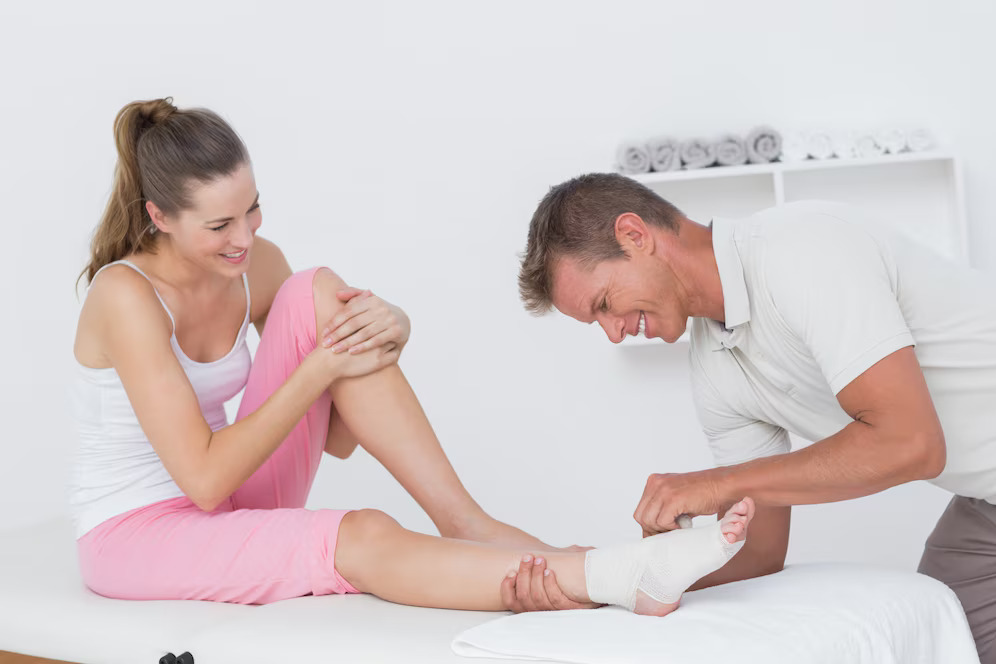Twisting your ankle during a run, landing awkwardly after a jump, or a misstep on the field – ankle sprains are a common injury for athletes and active individuals. While seemingly minor, a poorly treated ankle sprain can lead to chronic pain and instability, keeping you sidelined. This is where sports medicine plays a crucial role in getting you back in the game safely and effectively.
The Sports Medicine Approach to Ankle Sprain Treatment
Sports medicine focuses not just on treating the immediate injury but also on rehabilitation and preventing future occurrences. Here’s how a sports medicine approach benefits ankle sprain treatment:
- Accurate Diagnosis and Assessment: Sports medicine professionals, including doctors, physical therapists, and athletic trainers, are experts in musculoskeletal injuries. They will conduct a thorough physical examination to assess the severity of your sprain, identify any ligament damage, and rule out other potential injuries like fractures. They may also use imaging techniques like X-rays if necessary.
- Personalized Treatment Plans: Recognizing that every athlete and every sprain is unique, sports medicine practitioners develop individualized treatment plans. These plans consider the severity of the injury, your sport or activity level, and your specific goals for recovery.
- Emphasis on Early and Progressive Rehabilitation: Unlike simply resting the ankle, sports medicine emphasizes early and progressive rehabilitation. This involves a structured program of exercises designed to reduce pain and swelling, restore range of motion, improve strength and stability, and regain proprioception (your body’s awareness of its position in space).
- Focus on Functional Recovery: The goal of sports medicine isn’t just to heal the ankle but to ensure you can return to your sport or activity at your pre-injury level without pain or instability. Rehabilitation exercises are tailored to mimic the movements and demands of your specific activities.
- Injury Prevention Strategies: Sports medicine professionals also focus on identifying and addressing factors that may have contributed to the sprain. They can provide guidance on proper warm-up techniques, appropriate footwear, taping or bracing strategies, and exercises to strengthen supporting muscles and improve balance, helping to prevent future ankle sprains.
The RICE Protocol and Beyond
Initially, the RICE protocol (Rest, Ice, Compression, Elevation) is crucial for managing pain and swelling in the acute phase of an ankle sprain. However, sports medicine goes beyond this initial management. Your rehabilitation program might include:
- Pain and Swelling Management: Continued use of ice, compression, and elevation, along with pain medication if needed.
- Range of Motion Exercises: Gentle movements to restore the ankle’s ability to move freely.
- Strengthening Exercises: Exercises targeting the muscles around the ankle, including the calf muscles, peroneal muscles, and tibialis anterior.
- Balance and Proprioception Training: Exercises on uneven surfaces or using balance boards to improve your ankle’s stability and awareness of its position.
- Sport-Specific Exercises: Gradually introducing movements that mimic the demands of your sport or activity as your ankle heals and strengthens.
- Return-to-Play Guidelines: A carefully monitored progression back to full activity, ensuring your ankle can withstand the stresses involved.
Why Choose Sports Medicine for Your Ankle Sprain?
Choosing a sports medicine approach for your ankle sprain offers several advantages:
- Faster and More Complete Recovery: The focus on active rehabilitation helps you regain full function and return to your activities sooner and with a lower risk of re-injury.
- Reduced Risk of Chronic Problems: Proper treatment and rehabilitation minimize the likelihood of developing chronic pain, instability, or recurrent sprains.
- Expert Guidance and Support: You’ll receive guidance from professionals who understand the demands of athletic activity and are dedicated to helping you achieve your recovery goals.
- Prevention of Future Injuries: By addressing underlying factors and implementing preventative strategies, sports medicine helps you stay healthy and active in the long run.
Conclusion
An ankle sprain doesn’t have to sideline you permanently. With the comprehensive and proactive approach of sports medicine, you can receive the expert care and rehabilitation needed to heal properly, regain your strength and stability, and get back to doing what you love. Don’t underestimate the importance of proper treatment – it’s the key to a successful recovery and preventing future problems.
FAQs
1. How soon after an ankle sprain should I see a sports medicine professional?
It’s best to seek evaluation as soon as possible after an ankle sprain to ensure accurate diagnosis and prompt initiation of appropriate treatment.
2. Will I need an X-ray for my ankle sprain?
An X-ray may be necessary if there is suspicion of a fracture, based on the physical examination findings.
3. How long will it take to recover from an ankle sprain with sports medicine treatment?
Recovery time varies depending on the severity of the sprain, but a sports medicine approach aims for a faster and more complete return to activity through structured rehabilitation.
4. Will I need to wear a brace after my ankle sprain?
Bracing may be recommended for a period to provide support and stability, but the goal is to wean off the brace as your ankle strengthens through rehabilitation.
5. What can I do to prevent future ankle sprains?
Sports medicine professionals can provide guidance on exercises to strengthen ankle muscles, improve balance, and proper techniques for your sport or activity to minimize the risk of re-injury.
Contact Us
If you’ve experienced an ankle sprain and want to get back to your active lifestyle safely and effectively, contact our sports medicine clinic today. Our team of experienced professionals is dedicated to providing you with comprehensive care and personalized rehabilitation programs. Call us at (281) 741-3204 or visit our website at https://scchouston.co/ to schedule an appointment. Let us help you get back in the game!

